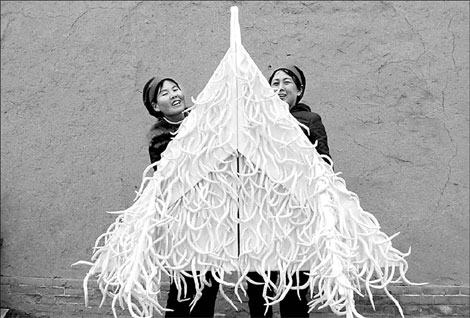Creative solution
"Poverty alleviation through art" is an initiative by artist Wen Fang to help the underprivileged who have been the inspiration for her work.
|
|
|
Woman holding a finished piece designed by artist Wen Fang. [China Daily] |
Artist Wen Fang has been looking for a way to address the needs of the underprivileged migrant workers, orphans, and homeless wanderers who have been her artistic inspiration since 2007. "Art is about resolving problems through creative means," the 34-year-old Beijing native says.
"I ask myself whether I can do more for these people beyond raising questions and criticisms."
She is now pursuing an idea she calls "poverty alleviation through art".
Her first attempt is Textile Dreams, a series of 23 craftworks by women from the handicraft cooperative Hundred Flowers of Magaozhuang (Hundred Flowers), based on her designs.
Hundred Flowers is situated in drought-stricken Yuwang, a small town in Tongxin county of Ningxia Hui autonomous region, one of the country's poorest regions with an annual income averaging 1,700 yuan ($250) per capita. Started in 2007 with the help of the French non-profit organization Women of Ningxia, Hundred Flowers now has a membership of about 60 women, aged between 28 and 55.
|
|
|
Women working on their embroidery pieces at the handicraft cooperative Hundred Flowers of Magaozhuang in the Ningxia Hui autonomous region. [China Daily] |
"Embroidery is an essential in the local girls' education," says Ma Xiaohua, president of Hundred Flowers.
"In my village, few have the chance to go to school. I only attended primary school myself. But since I was 12, I have practiced embroidery."
Having completed the design, Wen stayed with 15 members of the cooperative for a month - from March to April this year - to finish the 23 pieces. However, coordinating the team of undereducated women to work together efficiently still proved to be hard work.
But the project remained on track, "thanks to the management skills gained from my previous work as a web designer; it would otherwise easily have got out of control," she says.
"At the end of the day we made it. Each member earned 1,000 yuan ($148) on average. They were satisfied with it."
From May to June, the artworks were on show and on sale at a gallery in Beijing. To date, over a third of them have been purchased. Twenty five percent of the revenue will go to the artist, another 25 percent to the gallery, and the remaining 50 percent will be transferred into a fund to organize training programs for the Hundred Flowers' members and finance new art projects.
 |
|
Wen says her experience as a web designer came in handy for her art project. [China Daily] |
"Only when benefits for each of the three parties concerned - the artist, the gallery, and the women - are ensured, can the project be sustained," says Wen.
Wen says she knows what it means to be poor. She still remembers how she was estranged from classmates in primary school, simply because she couldn't afford the 2.5 yuan ($0.4), charged by the teacher for after-class supervision.
She has been exploring the lives of the underprivileged and taking photos of them since 18, when she started photographing the derelict buildings, the piles of rubble, the construction sites, the homeless wanderers, and the random subway passengers.
A web designer for six years after graduation from the Central Academy of Fine Arts, Wen went to study photography at a photography and cinema school in Paris. But it was only after her 2008 trademark Bricks of Migrant Workers that she was finally able to shake off financial concerns.
Following that hard-won success, Wen's commitment to those in need became even stronger. She has been a frequent participant in various charity events.
"But most of them are only one-off events, which made no real change," she says.
She learnt of the Hundred Flowers handicraft cooperative while talking with a French friend. And it occurred to her that she could cooperate with them by combining their traditional skills with her modern art.
"I hope this will become a long-term project," Wen says, who is now busy with an art show in Paris.
But at the end of August, she will set off again for the village where Ma and her fellow team members live in Ningxia to conduct her second project on a larger scale.
"Hundred Flowers has created in us the hope for a better future," says Ma, mother of three children.
 0
0 









Go to Forum >>0 Comments